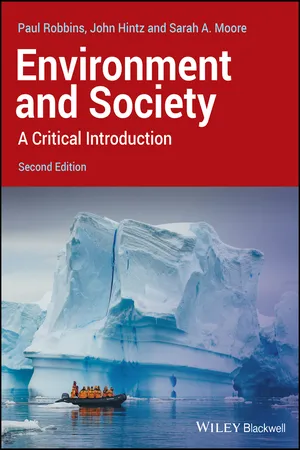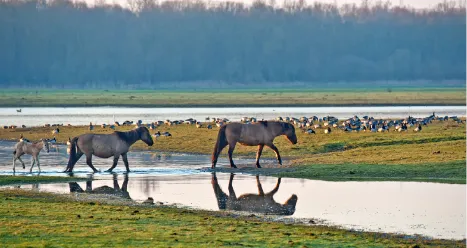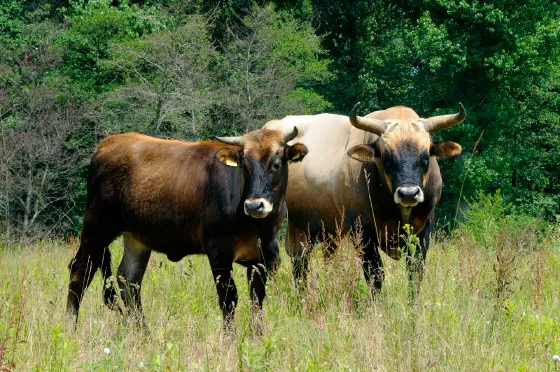
eBook - ePub
Environment and Society
A Critical Introduction
- English
- ePUB (mobile friendly)
- Available on iOS & Android
eBook - ePub
About this book
Substantially updated for the second edition, this engaging and innovative introduction to the environment and society uses key theoretical approaches to explore familiar objects.
- Features substantial revisions and updates for the second edition, including new chapters on E waste, mosquitoes and uranium, improved maps and graphics, new exercises, shorter theory chapters, and refocused sections on environmental solutions
- Discusses topics such as population and scarcity, commodities, environmental ethics, risks and hazards, and political economy and applies them to objects like bottled water, tuna, and trees
- Accessible for students, and accompanied by in-book and online resources including exercises and boxed discussions, an online test bank, notes, suggested reading, and website links for enhanced understanding
- Offers additional online support for instructors, including suggested teaching models, PowerPoint slides for each chapter with full-color graphics, and supplementary images and teaching material
Frequently asked questions
Yes, you can cancel anytime from the Subscription tab in your account settings on the Perlego website. Your subscription will stay active until the end of your current billing period. Learn how to cancel your subscription.
No, books cannot be downloaded as external files, such as PDFs, for use outside of Perlego. However, you can download books within the Perlego app for offline reading on mobile or tablet. Learn more here.
Perlego offers two plans: Essential and Complete
- Essential is ideal for learners and professionals who enjoy exploring a wide range of subjects. Access the Essential Library with 800,000+ trusted titles and best-sellers across business, personal growth, and the humanities. Includes unlimited reading time and Standard Read Aloud voice.
- Complete: Perfect for advanced learners and researchers needing full, unrestricted access. Unlock 1.4M+ books across hundreds of subjects, including academic and specialized titles. The Complete Plan also includes advanced features like Premium Read Aloud and Research Assistant.
We are an online textbook subscription service, where you can get access to an entire online library for less than the price of a single book per month. With over 1 million books across 1000+ topics, we’ve got you covered! Learn more here.
Look out for the read-aloud symbol on your next book to see if you can listen to it. The read-aloud tool reads text aloud for you, highlighting the text as it is being read. You can pause it, speed it up and slow it down. Learn more here.
Yes! You can use the Perlego app on both iOS or Android devices to read anytime, anywhere — even offline. Perfect for commutes or when you’re on the go.
Please note we cannot support devices running on iOS 13 and Android 7 or earlier. Learn more about using the app.
Please note we cannot support devices running on iOS 13 and Android 7 or earlier. Learn more about using the app.
Yes, you can access Environment and Society by Paul Robbins,John Hintz,Sarah A. Moore,John G. Hintz in PDF and/or ePUB format, as well as other popular books in Politics & International Relations & Environment & Energy Policy. We have over one million books available in our catalogue for you to explore.
Information
Edition
2Subtopic
Environment & Energy Policy1
Introduction
The View from a Human-Made Wilderness

Source: Oostvaardersplassen, a nature reserve in the Netherlands.
Keywords
- Anthropocene
- Political ecology
- Reconciliation ecology
- Rewilding
Chapter Menu
What Is This Book?
The Authors' Points of View
News headlines from forests, fields, rivers, and oceans suggest we are in a world of trouble. Storms ravage the coasts of Asia and the Americas, with more looming as sea levels slowly rise. Fresh water is increasingly scarce around the globe, owing not only to heavy water use but also widespread pollution; there is not a single drop of water in the Colorado River in the United States or the Rhone River in France that is not managed through complex dams and distribution systems, or affected by city and industrial waste along their paths to the sea. Agricultural soils are depleted from years of intensive cropping and from the ongoing application of fertilizers and pesticides in the search for ever-sustained increases of food and fiber; in North India, after decades of increasing production, yields of wheat and rice have hit a plateau. Global temperatures are on the rise and, with this increase, whole ecosystems are at risk. Species of plants and animals are vanishing from the Earth, never to return. Perhaps most profoundly, the world's oceans – upon which these global systems rest – show signs of impending collapse. The accumulation of these acute problems has led observers to conclude that the environment may be irreversibly lost or that we may have reached “the end of nature” (McKibben 1990).
And yet in Flevoland, a province in the Netherlands, wild species are thriving as never before. Red deer roam the landscape, feral horses travel in herds, and an ecosystem of foxes and wild birds has arisen, including egrets and wild geese. Aurochs – the massive wild cattle of Europe – have been extinct for centuries, but their human-bred cousins, Heck Cattle, graze the landscape, their long horns and hairy forms rumbling across the marshland (Figure 1.1). This 15,000-acre wilderness, called Oostvaardersplassen, is filled with wild life. Remarkably, all this wildlife is thriving in one of the places on Earth most densely populated by people. For safari visitors, who pay 45 dollars for a visit to the park, there is no question that the place creates a great sense of wonder, as visits to wild places do for most all of us in a world that is increasingly encroached by human activity, pollution, and influence.
Figure 1.1 Heck Cattle. Source: Roel Hoeve/Foto Natura/Corbis.

But if this place is a wilderness, it is by no means a natural one. Envisioned and created by biologists in the 1980s, this park had previously been little more than muddy lowlands devoid of wildlife. Over time, and with the careful introduction of various animals and plants, the landscape has been crafted to produce these animals. Most notably, the very ground upon which the park sits was reclaimed from the sea, as much of Dutch land was long ago. In the time of the Aurochs, Oostvaardersplassen would have been under meters of water! Though intended to mimic a late Pleistocene (10,000-year-old) ecology, therefore, the place is artificial. It is the product of rewilding, where long-lost ecosystems are crafted by people from whole cloth, in order to reclaim – or create – landscapes as they might have been before human influence (Kolbert 2012).
Rewilding A practice of conservation where ecological functions and evolutionary processes, which are thought to have existed in past ecosystems or before human influence, are deliberately restored or created; rewilding often requires the reintroduction or restoration of large predators to ecosystems
The wonderful landscapes of Oostvaardersplassen therefore raise as many questions as they answer. Which animals are introduced and which are not? Who says this state, devoid of people, is the natural one? Where some animals like the Aurochs are extinct, is a human-bred substitute ecologically acceptable? Given that the Heck Cattle were in fact bred by the Nazis in their effort to restore “pure” European nature, are such introductions socially acceptable? In a world desperate for the protection of existing wilderness (to say nothing of clean water and air), are expensive efforts at creating new wildernesses practical, or elitist?
This view from the Netherlands makes our global situation easier to understand, though perhaps no simpler to solve. The contradictory proposition – dramatically transforming the environment in ways that may preserve the environment – is a metaphor for the condition of our longstanding relationship to the non-human world. From this view, Oostvaardersplassen is in no way unique. Yellowstone National Park in the United States, though heralded as a wilderness, was created through the violent extirpation of the dozens of native tribes who lived in the region, transformed its landscapes, and relied on the resources of what would become a park devoid of people. Coffee plantations throughout Asia and Latin America, though regarded purely as economic and artificial landscapes, often teem with wild birds, mammals, and insects, all beyond the intent and control of farmers, conservationists, or anyone else for that matter. Everywhere we seek some place beyond people, the marks of human creation and destruction confront us, and wherever the works of humans are in evidence, there are non-human systems and creatures, all operating in their own way.
Decisions made in places like Oostvaardersplassen, therefore, cannot be made solely on the basis that the region is a “natural” one, nor a “social” one. The area is simultaneously neither and both, with animals, plants, and waterways springing from human interventions, creating altogether new habitats and environments. Wildlife parks and coffee plantations are both landscapes of the Anthropocene, therefore, one term for our current era, when people exert enormous influence on the Earth, but where control of these environments and their enormously complex ecologies is inevitably elusive.
Anthropocene A metaphoric term sometimes applied to our current era, when people exert enormous influence on environments all around the Earth, but where control of these environments and their enormously complex ecologies is inevitably elusive
If decisions about what to do (and what not to do) are to be made, and the larger complex puzzle of living within nature is to be solved, we need tools with which to view the world in fresh ways and assess possible routes forward. For example, viewed as a problem of ethics, the creation of a Dutch wilderness becomes one of sorting through competing claims and arguments about what is ethically best, on whose behalf one might make such an argument (that of people with competing claims on the scarce resources required in this undertaking or that of the animals themselves?), and over which criteria we might use to adjudicate “good” policy. From the point of view of political economy, by contrast, one would be urged to examine what value is created and destroyed in the transformation of these muddy lands, which specific species are selected and why, whose pockets are filled in the process, and how decisions are controlled and directed through circuits of expert power and conservation authority. Indeed, there is no shortage of ways to view this problem, with population-centered considerations competing with those that stress market logics, and arguments about public risk perception competing with those about the romantic social construction of the park.
What Is This Book?
This book is designed to explain these varied interpretive tools and perspectives and show them in operation. Our strategy is first to present the dominant modes of thinking about environment–society relations and then to apply them to a few familiar objects of the world around us. By environment, we mean the whole of the aquatic, terrestrial, and atmospheric non-human world, including specific objects in their varying forms, like trees, carbon dioxide, or water, as well as the organic and inorganic systems and processes that link and transform them, like photosynthesis, predator–prey relationships, or soil erosion. Society, conversely, includes the humans of the Earth and the larger systems of culture, politics, and economic exchange that govern their interrelationships.
From the outset we must insist that these two categories are interlaced and impossible to separate. Humans are obviously environmental beings subject to organic processes. Equally problematically, environmental processes are also fundamentally social, in the sense that they link people and influence human relationships. Photosynthesis is the basis of agriculture, for example, and so is perhaps the most critical environmental process in the history of civilization. More complex: human transformation of carbon levels in the atmosphere may further alter global photosynthesis in a dramatic way, with implications for human food and social organization. Obviously, it is difficult to tell where the environment leaves off and society begins. On the other hand, there is not universal agreement on these relationships and linkages. The perspectives summarized in this text present very different views about which parts of society and environment are connected to which, under what conditions these change or can be altered, and what the best courses of action tend to be, with enormous implications for both thinking about our place in the ecosystem and solving very immediate problems like global warming, deforestation, or the decline in the world's fisheries.
In Part I, we lay out some of the dominant ways of interpreting the environment–society relationship. We begin in Chapter 2 with a perspective that is foundational to the history of both the natural and social sciences: population. Here we describe how human population has been viewed as a growing threat to the non-human world, contrasting this with views of population growth as a process that not only consumes, but also potentially produces, resources in the world. In Chapter 3 we consider economic ways of thinking about the environment. These views stress the power of markets – a category in which we include systems of economic exchange – to respond to scarcity and drive inventive human responses. This is followed in Chapter 4 by approaches that stress institutions, which we define as the rules and norms governing our interactions with nature and resources. Institutional approaches address environmental problems largely as the product of “common property” problems that are amenable to creative rule-making, incentives, and self-regulation. Chapter 5 examines ethics-based approaches to the environment, with their often radical ways of rethinking the place of humans in a world filled with other living and non-living things. The view of the environment as a problem of risk and hazard is explored in Chapter 6. That approach proposes a series of formal procedures for making the best choices possible, given that environments and environmental problems are inherently uncertain and highly variable. This is followed by a description of political economy approaches in Chapter 7, which are those that view the human relationship with nature as one rooted in the economy, but which insist that the economy is based in, and has fundamental implications for, power relationships: who gets what, who works for whom, and who pays. Contrary to market-based approaches, these point to the environmentally corrosive impacts of market economics. Chapter 8 closes this part of the book by describing approaches to environment and society issues that stress social construction, which we define as the tendency for people to understand and interpret environmental issues and processes through language, stories, and images that are often inherited or imposed through systems of media, government, education, or industry. These stories are not harmless, since they can encourage or overlook very real actions, impacts, and behaviors with serious environmental and social consequences.
Within these several ways of seeing are many others, of course. Within political economy, for example, issues of environmental justice are critical to understanding why some people are more heavily exposed to hazards than others. We have nested many of these perspectives within larger categories of thought, though without pretending we can do more than introduce many important concepts. Of particular significance are issues related to gender. These are so important, indeed, that we chose not to set them aside in a separate chapter, but to thread them throughout the book, amidst themes as varied as population and political economy.
Part II presents a set of nine critical objects, and examines each of them in turn using a sample of these approaches. Each chapter begins with a “short history” of the object followed by a discussion of ways in which the characteristics of the object present a puzzle or conundrum, and then presents divergent ways of thinking about the object from competing points of view. In Chapter 9, we introduce carbon dioxide, a curious gas with a complicated history on Earth that shows it to vary widely over time, with enormous implications for the forms of life dwelling here. As one of the most important greenhouse gases, moreover, CO2 has become an increasingly contested object, with competing views about its control, regulation, and circulation. In Chapter 10, we discuss trees. These plants have been companions of human civilization since the beginning, though the long relationship has been marked by dramatic ebbs and flows. In this chapter we take the opportunity to introduce varying theories to account for deforestation and reforestation, as well as a startling ethical proposal for trees to legally represent themselves. Chapter 11 is dedicated to wolves, a species with which hum...
Table of contents
- Cover
- Critical Introductions to Geography
- Title page
- Copyright page
- List of Figures
- List of Tables
- List of Boxes
- Acknowledgments
- 1: Introduction: The View from a Human-Made Wilderness
- Part 1: Approaches and Perspectives
- Part 2: Objects of Concern
- Glossary
- Index